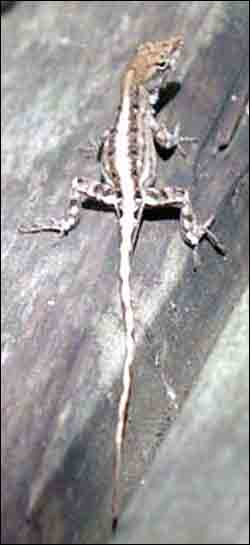Tracing genes, biologists show lizard migration is traced to Florida

Genetic studies performed by Washington University biologists shows that the sunshine State is the exporter of brown lizards to other countries. Photo courtesy U.S. Geological Survey/SOFIA
A new study headed by biologists at Washington University in St. Louis shows that Florida is an exporter of more than just fruit and star athletes.
Studying genetic variation in the common brown lizard, Anolis sagrei, the researchers found that introduced populations of the lizard in five different countries can be traced back to the Sunshine State as their site of export.
The team analyzed a small region of DNA from more than 600 different individuals to get a genetic “ID card” for each lizard. The historic home for Anolis sagrei is the Caribbean, especially Cuba, where the researchers have found that there are at least eight genetically distinct groups of the lizard. In the late 1800s, Anolis sagrei was introduced (probably through a shipment of goods) to the Florida Keys, got a toehold and, after a decades-long lag, began spreading into the Florida mainland in the 1940s, most likely from separate introductions.
Jason Kolbe, a doctoral candidate in biology at Washington University, gathered genetic samples of Anolis sagrei throughout Florida in 2003. Using a genetic database for Anolis sagrei developed in collaboration with fellow Washington University graduate student Richard Glor, he then analyzed the introduced samples in comparison to the Cuban ones, not only in Florida but also in Hawaii, Taiwan, Jamaica, Grenada and Grand Cayman.
The researchers were able to identify Florida as the source of new populations in the other countries by finding genetic variation shared by Florida and the other introduced populations. Genetic variants found in the newer locations more closely matched those of populations in Florida.
“The basic idea that drove this research was to determine where the newly introduced populations in Florida and elsewhere came from,” said Kolbe. “We discovered that once an introduced species gets established in an area it can become a source for introductions elsewhere. And we also found that genetic variation can actually increase during subsequent introductions because with each introduction to Florida, there is a new mixing of genes from the distinct Cuban source populations.”
Kolbe, Glor, Washington University biology professors Allan Larson, Ph.D., Jonathan Losos, Ph.D., and two Cuban collaborators in Havana published their results in the Sept. 9, 2004 issue of Nature magazine. The National Science Foundation and the Environmental Protection Agency Science to Achieve Results (STAR) program funded it.
Another motivation to analyze and observe the introduced populations was to see if the introduced species are having an impact on the Floridian ecosystem. It has been noted, Kolbe said, that Anolis sagrei will eat the small hatchlings of the Anolis carolinensis, the little green lizards native to the state. It has been noted, also, that some Florida populations of the introduced brown lizards have gotten larger than the usual brown lizard size. And the brown lizards have become prey to the Nile Monitor, a seven-foot-long lizard native to Africa, but also introduced in Florida, most likely a refugee from a pet store or hobbyist who wanted a unique pet.
“The green lizard populations are being reduced in Florida, especially in southern areas, because it appears that the brown lizard out-competes it,” Kolbe said. “It’s not really causing any problems for people, except for those who are partial to the green lizards and miss seeing them so much.”
The genetic changes occurring in the Florida populations are happening at a much quicker pace than that of typical Darwinian evolution – tens of years versus up to millions. That has caused speculation that a new species or two is evolving from the genetic card shuffling occurring in Florida.
“These lizards have become a grand experiment,” Kolbe said, referring to a long series of studies that Losos and Larson have performed on evolution in Caribbean lizards since the early 1990s. “Anoles have naturally moved all throughout the Caribbean, but the genes being mixed in Florida and elsewhere could potentially speed up evolution. What took millions of years before is happening in dozens of years, maybe even faster than that.”
Media Contact
More Information:
http://www.wustl.eduAll latest news from the category: Life Sciences and Chemistry
Articles and reports from the Life Sciences and chemistry area deal with applied and basic research into modern biology, chemistry and human medicine.
Valuable information can be found on a range of life sciences fields including bacteriology, biochemistry, bionics, bioinformatics, biophysics, biotechnology, genetics, geobotany, human biology, marine biology, microbiology, molecular biology, cellular biology, zoology, bioinorganic chemistry, microchemistry and environmental chemistry.
Newest articles

Bringing bio-inspired robots to life
Nebraska researcher Eric Markvicka gets NSF CAREER Award to pursue manufacture of novel materials for soft robotics and stretchable electronics. Engineers are increasingly eager to develop robots that mimic the…

Bella moths use poison to attract mates
Scientists are closer to finding out how. Pyrrolizidine alkaloids are as bitter and toxic as they are hard to pronounce. They’re produced by several different types of plants and are…

AI tool creates ‘synthetic’ images of cells
…for enhanced microscopy analysis. Observing individual cells through microscopes can reveal a range of important cell biological phenomena that frequently play a role in human diseases, but the process of…





















